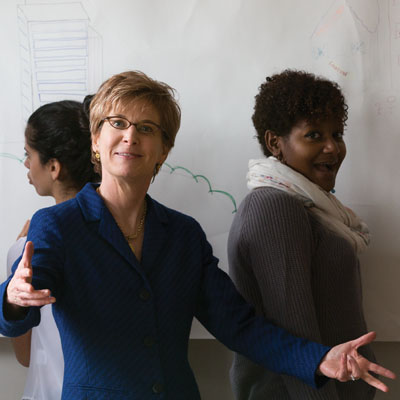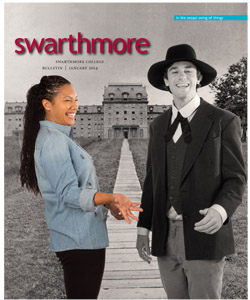Renaissance Woman
Through teaching—and learning—Professor Patricia Reilly lives the liberal arts

Patricia Reilly (center) often incorporates making art into her art history classes. Above, students Natalie Gainer ’15 (left) and Rachell Morillo ’14 work on a mural representing good and bad in the U.S. government as a means of analyzing 14th-century Italian political artist Ambrogio Lorenzetti. Photo by Laurence Kesterson
Patricia Reilly breezes into her cluttered Beardsley office one afternoon, gently cradling a steaming teacup. She apologizes for the piles of thick art books, stacked amid framed student artwork, explaining that her Parrish Hall office—where she’s spent the last two of her three-year appointment as associate provost for faculty development—is undergoing renovation.
She’s just returned from a faculty mentor lunch, which she gleefully characterizes as “cacophonous” due to the lively interaction between the senior faculty and their younger mentees. During her stint in the provost’s office, Reilly has expanded the scope of the mentoring program and overseen new-faculty orientation, weekly faculty lunches, and other programs that unite and enrich the College’s professoriate.
During her 12 years here, the art historian has seen how difficult it is for faculty members to get out of departmental silos to meet, interact, and collaborate. She has made it her goal to help the faculty do just that. This interest in transcending boundaries is one that is reflected in her personal history: A Californian by birth, she migrated East—attending Bryn Mawr College for her M.A.—to experience the culture. Afterward, she made inroads in the contemporary art world working with feminist artist Judy Chicago in the United States and abroad, and yet she eventually specialized in Renaissance art. Reilly returned West for a Ph.D. at UC–Berkeley in rhetoric—a department that included scholars from disciplines such as film, law, and classics. Throughout, Reilly has always sought to elucidate the “interdisciplinary and philosophical underpinnings of the practice and theory of art.”
As chair of the steering committee for the newly established Institute for the Liberal Arts—a faculty-driven initiative arising from the campus Strategic Plan—Reilly has enjoyed a familiar challenge of finding a nexus among disciplines to create a campuswide liberal arts experience. She explains her process for uniting people and ideas—in the classroom and beyond—to Bulletin writer Carrie Compton.
What was your earliest interest in art?
My mother was very talented; she was interested in drawing and painting, which I took to naturally as a child. I thought I was going to be a studio artist, and then I realized my gifts were less in making art and more in interpreting and appreciating it.
In graduate school I discovered that the early Renaissance was a period when artists started to self-consciously analyze what they were doing and why, especially in relation to other intellectual and creative activities, such as poetry, music, and mathematics. That moment in history is what made me decide I wanted to become a Renaissance art historian.
Is Renaissance-era art your favorite?
My favorite kind of art is art that draws you in and says, “I am a sophisticated pictorial solution to a perceptual and intellectual puzzle—a deposit of aesthetic choices and historical, religious, and social circumstances.” I like art that invites you to work with it to puzzle those things out. For me, the Renaissance is the most fun period in which to do this, because I know that world so well.
How are you able to get students to contextualize art with presumably little specialized knowledge of an era?
I start out by telling them, “every image is an argument attempting to persuade you. If you can analyze how that argument is constructed, you can find meaning in a work.” I begin by asking students to carefully look at works of art, purely in formal terms, thinking about how the image leads the eye. I’ll display two images that depict the same subject matter, such as a crucifixion—because we talk a lot about Christian art in the Renaissance—and analyze how those pieces can be very different in their interpretations: One might emphasize Christ’s human suffering, while the other emphasizes his relationship to Mary as the representative of the church. Once we analyze the vocabulary of the image we then discuss the role of the patron, the “period eye” of the viewer, and then all the cultural, political, and social meanings that are deposited in that painting.
What is your goal for students to take away from that experience—in a larger liberal arts sense?
I want students to know the importance of understanding an image on its own terms, rather than through preconceived and contemporary notions. Works of art, like people, are complicated, and they require viewers to step out of their comfort zones and expectations in order to understand them. By discussing images in groups, students come to understand one another as much as the image. They come to appreciate different perspectives, both literally and metaphorically. I often say, “If we could just have representatives of warring countries stand in front of a painting and talk about it, they would realize how many experiences and values they actually share.”
Another important skill I hope my students take away is the ability to critically analyze an image. We live in a culture where images are a primary source of information and persuasion, and yet, visual intelligence is not something they are taught in school.
Talk about your stint as the associate provost for faculty development.
There are many elements of this position that I find engaging. One is the faculty mentor program. I’ve added a more social element to the traditional pairings by creating mentor cohorts of five mentor/mentee pairs that get together to offer each other support and wisdom. These groups allow a member to lob out a question like, “What kinds of assignments do you find most productive?” or “How do you engage a quiet student” and get a variety of answers. These cohorts also create opportunities for natural affinities and friendships to arise.
How has your provost’s office appointment factored into your role in the Institute for the Liberal Arts committee?
My work with the Institute for the Liberal Arts has been one of the most pleasurable and rewarding experiences I have had working here, and I’ve had a lot of great experiences. The institute was created to inspire the quality and inventiveness of Swarthmore College’s liberal arts practices and to promote the understanding of the liberal arts on a national and international stage. It nurtures the dynamic intellectual community of the Swarthmore College faculty. Our faculty are so dedicated, innovative, smart, and creative, and the institute provides them with the support they need to collaborate with one another. And all of this goes right into the classroom.
An example of this is the faculty seminar on poverty and inequality, which is made up of colleagues in economics, biology, religion, history, philosophy, sociology and other disciplines. Together these faculty members are investigating how different disciplines approach and interpret these topics and are using this knowledge to inform their own teaching and research. Next year the institute will sponsor a faculty seminar on pedagogy, where six pairs of faculty will sit in on each other’s classes during the semester. The 12 will also meet in a seminar to discuss best practices in teaching, coach each other, and bring in outside sources. These faculty seminars allow colleagues to work across departments, and they create a community of faculty who share with, learn from, and inspire each other. The institute provides the structure and support necessary for these important activities to happen.
In sum, the idea for the Institute came out of a faculty desire for these kinds of opportunities and my being on the committee as associate provost was a perfect fit. I’m very happy to say that I was in the right place at the right time.
 Email This Page
Email This Page